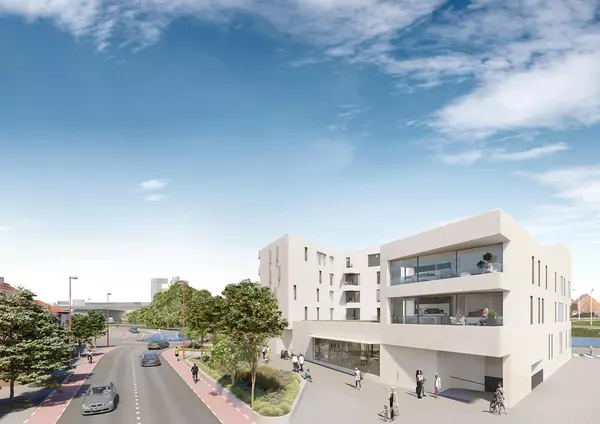Long-planned Oceanside Transit Center redevelopment hits snag
The Oceanside City Council has delayed its decision on whether to approve a sweeping redevelopment proposed for the Oceanside Transit Center, creating a new hurdle the developer said could kill the project.
Toll Brothers has been working for years on plans to build 547 apartments in two, five-story buildings, along with a four-story office building, a 170-room hotel, retail shops and more on the property owned by North County Transit District.
The City Council voted 3-2 Tuesday, with members Peter Weiss and Rick Robinson opposed, to continue the issue to a Nov. 19 meeting. The move came after the council raised questions about plans to reroute bus traffic through the site, pay prevailing wages for workers, the amount of public open space available, and the percentage of apartments reserved for low-income tenants.
“If this gets continued, i don’t think we will be back,” Toll Brothers Managing Director Michael McCann told the City Council. “We’ve been at it for 15 years … my management, they have cut off all spending to this project until we can show it will go on.”
Toll Brothers is unlikely to accept some of the changes proposed by the City Council and the public, he said.
NCTD’s Coaster and Sprinter trains and Breeze buses use the transit center, along with Amtrak, and Metrolink trains.
After widely advertising the project, NCTD’s board of directors approved an 18-month exclusive negotiating agreement in 2020 with Toll Brothers for the transit-oriented, mixed-use development on the site’s 10.2 acres. Since then, the negotiating agreement has been extended seven times as the developer, the district and the city struggle to iron out details.
Residents near the transit center have said for years that they generally support the project except for the rerouted buses. They object to relocating the bus station to the southern end of the property, which includes changing bus traffic to exit onto Missouri Avenue and other side streets instead of Seagaze Avenue as it does now.
“Although there are housing benefits to the OTC redevelopment, their bus bay relocation … creates huge negative impacts to the surrounding neighborhood,” said Cleveland Street resident James Filanc, a member of the Oceanside Safe Streets Association, in a letter to city officials.
“Mixing residential, commercial, cycling and pedestrian uses pose big safety collision risk issues,” Filanc said, and he urged the city, the transit district and the developer to consider other alternatives.
NCTD’s board of directors approved moving the bus bays and changing the bus routes in 2008, said the district’s Chief Executive Officer Shawn Donaghy.
Since then, the district has been waiting for the redevelopment plan to be approved to make the change, but it will proceed with or without the redevelopment, Donaghy said.
The new route is needed because of the increasing traffic on Seagaze, he said. Also, Seagaze will get even more vehicles after the City Council’s approval last week of a seven-story building with 326 apartments, retail stores and restaurants to replace the 25-year-old Regal Cinema complex between Seagaze and Mission Avenue, with its parking garage access on Seagaze.
Wider sidewalks and other features in the transit center development would improve pedestrian safety, Donaghy said, and the buses would be a relatively small percentage of the traffic.
Also, in response to concerns about diesel fumes, he said that before construction is completed, all the district’s public transit vehicles will have zero emissions under a mandatory transition to an electric and hydrogen-powered fleet.
City Manager Jonathan Borrego said any change in the bus plan is unlikely.
“Our staff has had extensive conversations with all parties on the bus routings,” Borrego said. “I don’t thing there is going to be any movement on the routing.”
The residential portion of the property includes the designation of 15% of the apartments for affordable housing, of which 10% would be for low-income tenants and 5% for moderate income tenants.
Joyce said he would like the entire 15% of affordable housing to be designated for low-income tenants. Also, he and Councilmember Jimmy Figueroa asked for the developer to guarantee that prevailing wages are paid for all construction jobs in the project.
McCann did not address those issues in detail, but the proposed changes could add significant costs for the developer.
Councilmember Rick Robinson said the project is good, and that he saw no need to debate the details further.
“Here again, we are trying to make the perfect out of the good,” Robinson said.
The council’s decision also stopped progress on a separate but related project on Tuesday’s agenda, the construction of a seven-story building with 206 apartments on the present site of NCTD headquarters at 810 Mission Ave. The present building there would be demolished after NCTD moves into the new office building at the transit center.
The new Mission Avenue building also would include 15% reserved as affordable housing. McCann asked for that project also to be continued to Nov. 19, and the council voted 3-1 in favor, with Weiss opposed and Robinson absent. He left the meeting just before the vote.
The transit center faces Tremont Street, two blocks south of Mission Avenue and a quarter-mile from the beach. Much of the site is covered by under-used street-level parking. It is one of 11 train stations across North County that NCTD plans to redevelop with transit-oriented, mixed-use projects.
Adding housing and commercial buildings at transit centers is intended to increase ridership on buses and trains and boost the district’s revenue from long-term property leases, transit officials have said.
Categories
Recent Posts










GET MORE INFORMATION


